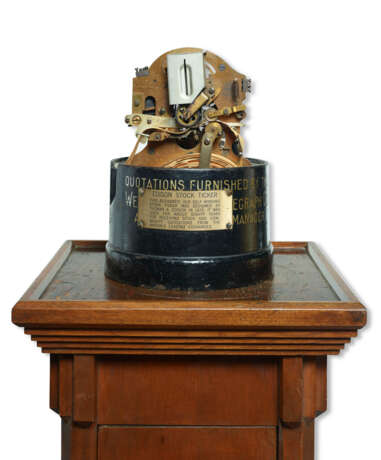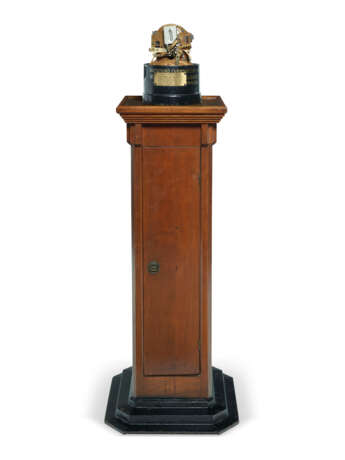ID 1236400
Lot 169 | A brass telegraphic stock ticker
Estimate value
$ 10 000 – 15 000
Brass mechanism, 270 x 130mm (10 1/2 x 5 1/8 in.), with roll of used ticker paper and set into a 207mm (8 1/4 IN.) diam. cast iron base painted black with explanatory brass plaque affixed with screws over original painted Western Union notice, additional Western Union service decal on reverse (some chipping to paint, occasional pitting to brass housing, mechanism not tested). Stand with integral cabinet: 1067mm (42 in.) tall, cast iron base: 457 x 457mm (18 x 18 in.), top stand, 356 x 356mm (14 x 14 in.). Two holes placed at center of the top of stand to accommodate wiring (typical wear including surface scratches and scuffs).
An original Edison Universal Stock Printer with period stand: the first mechanical means for transmitting real-time stock market data from exchange floors to brokers and investors across the country. Edison’s ticker drastically altered the landscape of New York finance in the late 19th century as it received and simultaneously printed quotes for stocks, bonds, and commodities via Western Union telegraph. The stock ticker was invented by Edward Calahan in 1868 for the Gold and Stock Telegraph Company in New York. Edison developed his universal ticker in 1871, also for Gold and Stock (later a subsidiary of Western Union). His most substantial improvement to Calahan’s invention was a mechanism that enabled all tickers on a line to synchronize so that they printed the same information.
| Artist: | Thomas Edison (1847 - 1931) |
|---|---|
| Place of origin: | USA |
| Auction house category: | All other types of objects, Medicine & science |
| Artist: | Thomas Edison (1847 - 1931) |
|---|---|
| Place of origin: | USA |
| Auction house category: | All other types of objects, Medicine & science |
| Address of auction |
CHRISTIE'S 8 King Street, St. James's SW1Y 6QT London United Kingdom | |
|---|---|---|
| Preview |
| |
| Phone | +44 (0)20 7839 9060 | |
| Buyer Premium | see on Website | |
| Conditions of purchase | Conditions of purchase |







